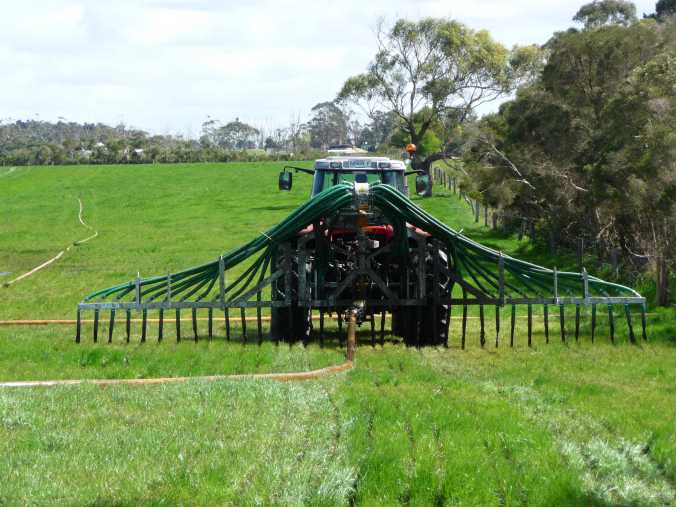I will never look at cow poo the same way again. A revolutionary technology arrived at the farm this week that is a huge win for the environment and for the farm.
While most of the manure produced by our cows (and they dump a massive 40 litres each every day!) goes straight back onto the paddock, we do have to wash away the stuff that drops on the dairy yard while they’re waiting to be milked.
Rather than allow it to pollute our waterways, we collect it in an effluent pond to be applied on the paddocks as fertiliser. Sounds ideal but, unfortunately, there’s been a deal of guesswork in knowing exactly what’s in it and what rate to spread.
The only way until now was to agitate the pond (at significant expense) and send a sample off to a lab before agitating it all over again and getting it out with a slurry tanker that literally splashes it all over the pasture like Vegemite on toast.
The local and forward-thinking Bowden’s Agricultural Contracting owner, Wayne Bowden, has just bought a Slurry Kat that monitors the nitrogen content of the effluent as it’s pumped out and lets me choose just how much is applied per hectare.
In practice, that means instead of saying: “Aaah, about a quarter inch thick, please”, I can say “60 units of N per hectare, please”. Wayne can even tell me how much phosphorous is going on.
Why do I care? It means less likelihood of leaching excessive nutrients and we don’t use too much or too little bought-in fertiliser.
How the Slurry Kat works
The Slurry Kat system involves three tractors:
- An agitator that ensures the heavy slurry at the bottom of the pond isn’t left behind
- A pump stationed at the pond to push the effluent out to the paddock at up to 160,000 litres per hour via a 5″ hose.
- The spreader tractor, which uses lots of hoses to dribble the effluent along the ground in lines.
How it helps us manage our effluent for a better environment and greater productivity
Aside from the extra information and control the system brings us, the benefits are:
- Safety. Because there’s no need to reverse a tanker up to the effluent pond dozens of times, there’s less chance of someone falling in.
- Lower greenhouse gas emissions. Manure dribbled onto the ground rather than splashed onto a plate and sprayed means less volatilisation of its nitrogen.
- We can affordably apply effluent to paddocks 1.5 km from the effluent pond rather than limiting ourselves to those close-by.
- Less odour. I couldn’t smell it from the road.
- Lower access requirements – less damage to tracks and paddocks near gateways
- Quicker return to pasture because there’s no thick slurry to wash off leaves.
I love it (and, no, I didn’t get paid to say any of this)!





Apologies to those equipment suppliers who wanted to promote their own gear. That’s not suitable comment for my blog.
LikeLike
Awesome!
Very happy to see this!
Personally, I am a fan of spreading it back out, regardless of the ability to analyse the contents and makeup of the “product” for no other reason than you are not “exporting” all of the nutrients of the paddocks and returning some of it back. Also, the effluent allows for organic carbon and matter to build up, feeds the microbial life and in effect is an in-situ compost that sinks in under the grass surface.
In short, it allows for a far greater soil health and for a richer pasture 🙂
LikeLike
These issues are attached to dairy farming everywhere and Marians method of dealing with the effluent is very good indeed.
LikeLike
Pingback: For our children | The Milk Maid Marian
I loved this post! It makes me wish I had a dairy farm to spread it on my sad paddocks!
LikeLike
Pingback: The calm before the perfect storm for one nervous dairy farmer | The Milk Maid Marian